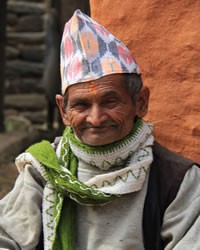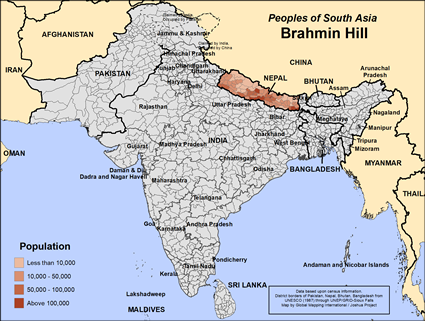Brahmin Hill in Nepal

Photo Source:
Harvey Blustain
|

Map Source:
People Group Location: Omid. Other geography / data: GMI. Map Design: Joshua Project
|
| People Name: | Brahmin Hill |
| Country: | Nepal |
| 10/40 Window: | Yes |
| Population: | 3,346,000 |
| World Population: | 3,346,000 |
| Primary Language: | Nepali |
| Primary Religion: | Hinduism |
| Christian Adherents: | 0.00 % |
| Evangelicals: | 0.00 % |
| Scripture: | Complete Bible |
| Ministry Resources: | Yes |
| Jesus Film: | Yes |
| Audio Recordings: | Yes |
| People Cluster: | South Asia Forward Caste - Brahmin |
| Affinity Bloc: | South Asian Peoples |
| Progress Level: |
|
Introduction / History
In South Asia, there are two countries with a Hindu majority: India and Nepal. Both share a long history involving the caste system, which involves four major groupings. Brahmins are a the highest of the four; they are known as a "forward" caste. The English word brahmin is an anglicized form of the Sanskrit word Brahmana. Brahman refers to the "Supreme Self" in Hinduism or the first of the gods.
Brahmins have many subgroups. In Nepal the major ones are the Upadhyaya, Jaisi, and Kumai. From there they are subdivided even further by location. That includes the so-called "Hill Brahmins," who usually reside in the southern and central parts of Nepal. They speak Nepali, the main language.
What Are Their Lives Like?
As needed, Hill Brahmins perform their traditional priestly duties, but they are more likely to be involved with other activities. Most are involved in agriculture, usually as landowners. Living in houses with walls made of stone or of mud bricks, they keep cattle and grow crops. Some of their villages rise as high as three thousand meters.
Hill Brahmins make up a little over 10 percent of Nepal's population and about 40 percent of the government administrators and workers. There are reasons for that. Brahmins often enjoy special privileges, and they excel in academics. Brahmin parents drive their children to excel academically. Even their religious upbringing trains their minds for advanced mathematics.
What Are Their Beliefs?
Most modern Gaur Brahmins do not espouse a doctrine of their superiority by birth above other peoples. Many are now secularists. But most Brahmins respect the ancient (and many not-so-ancient) traditions of their forefathers. Some work to synthesize modern science and Hindu beliefs and practices. There are hundreds of "denominations" of Hinduism and Brahmins have a presence in many; so it is not easy to generalize on what Brahmins believe. Some would be devotees of Vishnu or his avatars of Krishna or Ram, some would be devotees of Shiva, and some would be devotees of the goddess in one of her manifestations. Others are followers of modern gurus. Few today have seriously studied, let along memorized, the ancient Vedas; but one is more likely to find a person knowledgeable about the Vedas and other Hindu texts and teachings among Brahmins than among any non-Brahmin caste group.
What Are Their Needs?
Though the civil war with communist factions is over, those with wealth and power are vulnerable to guerillas in remote areas.
Prayer Points
Pray for the protection of Hill Brahmins.
Pray for Nepal's Hill Brahmins to become enlightened with the understanding of the supremacy of Jesus Christ.
Pray for a movement within Hill Brahmin families of disciples who make more disciples.
Pray for the Lord to thrust out the right workers to take Jesus Christ to the Hill Brahmins.